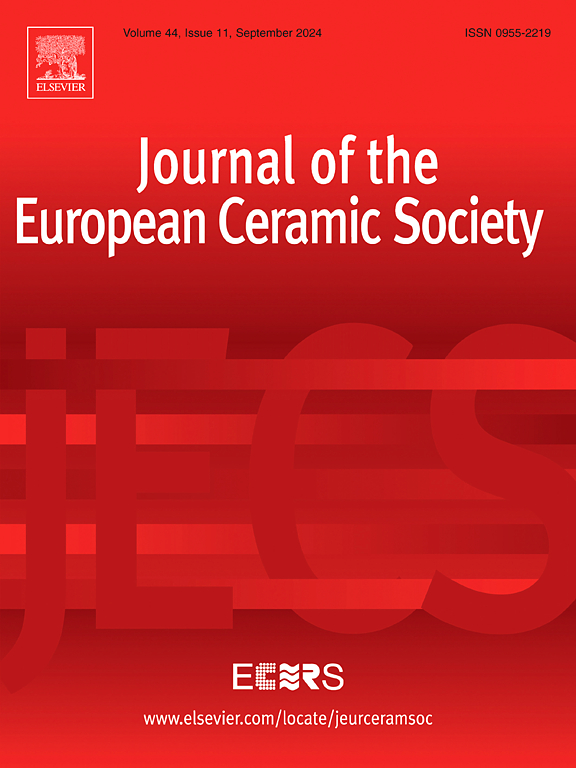增强高居里温度 CaBi2Nb2O9 陶瓷的压电特性和温度稳定性
IF 5.8
2区 材料科学
Q1 MATERIALS SCIENCE, CERAMICS
Journal of The European Ceramic Society
Pub Date : 2024-11-22
DOI:10.1016/j.jeurceramsoc.2024.117101
引用次数: 0
摘要
下一代喷气发动机、金属锻造工艺和核电站的无损监测都需要具有超高工作温度、超灵敏度和出色温度稳定性的压电传感器。铌酸铋钙(CaBi2Nb2O9,CBNO)具有接近 900 °C 的高居里温度 (TC),因此被认为是高温压电材料的候选材料。然而,纯 CBNO 的压电系数(d33)很低,高温电阻率(ρ)也很低。在这项研究中,通过在 A 位上共取代 Li/Ce 和在 B 位上共取代 W/Mo 构建伪四方晶界,CBNO 陶瓷的压电性、铁电性和电阻率都得到了显著改善。值得注意的是,Ca0.92(Li0.5Ce0.5)0.08Bi2Nb1.97(W2/3Mo1/3)0.03O9(CLCBN-3WM)陶瓷表现出了最佳性能:超高 TC(∼ 922 °C)、极高 d33(∼ 16.1 pC/N)、大剩极化(∼ 11.61 μC/cm2)、非常好的高温绝缘性能 ρ(600 °C 时为 7.4 × 105 Ω-cm)以及优异的热稳定性,从室温到 800 °C 时,其 d33 值从 16.1 pC/N 退化到 15.1 pC/N(小于 7.0%)。这些结果表明,CLCBN-3WM 陶瓷在高温(600 ℃ 或更高)条件下工作的机电传感器中具有巨大的应用潜力。本文章由计算机程序翻译,如有差异,请以英文原文为准。
Enhancement of piezoelectric properties and temperature stability of high-Curie temperature CaBi2Nb2O9 ceramics
Next-generation jet engines, metal forging processes, and non-destructive monitoring of nuclear power plants demand piezoelectric sensors with ultra-high operating temperature, exceptional sensitivity, and outstanding temperature stability. Bismuth calcium niobate (CaBi2Nb2O9, CBNO) is considered a candidate for high-temperature piezoelectric materials due to high-Curie temperature (TC) near 900 °C. However, pure CBNO shows a poor piezoelectric coefficient (d33) and low high-temperature resistivity (ρ). In this work, the piezoelectricity, ferroelectricity, and resistivity of CBNO ceramics were significantly improved by constructing pseudo-tetragonal boundary through the co-substitution of Li/Ce at A site and W/Mo at B site. Remarkably, Ca0.92(Li0.5Ce0.5)0.08Bi2Nb1.97(W2/3Mo1/3)0.03O9 (CLCBN-3WM) ceramic exhibits the best performance: ultra-high TC (∼ 922 °C), very high d33 (∼ 16.1 pC/N), a large remanent polarization (∼ 11.61 μC/cm2), and very good high-temperature insulation ρ (∼ 7.4 × 105 Ω·cm at 600 °C), as well as excellent thermal stability with its d33 value degeneration from 16.1 pC/N to 15.1 pC/N from room temperature to 800 °C (less than 7.0 %). These results indicate that CLCBN-3WM ceramics have significant potential for using in electromechanical transducers operating at high temperatures (600 °C or higher).
求助全文
通过发布文献求助,成功后即可免费获取论文全文。
去求助
来源期刊

Journal of The European Ceramic Society
工程技术-材料科学:硅酸盐
CiteScore
10.70
自引率
12.30%
发文量
863
审稿时长
35 days
期刊介绍:
The Journal of the European Ceramic Society publishes the results of original research and reviews relating to ceramic materials. Papers of either an experimental or theoretical character will be welcomed on a fully international basis. The emphasis is on novel generic science concerning the relationships between processing, microstructure and properties of polycrystalline ceramics consolidated at high temperature. Papers may relate to any of the conventional categories of ceramic: structural, functional, traditional or composite. The central objective is to sustain a high standard of research quality by means of appropriate reviewing procedures.
 求助内容:
求助内容: 应助结果提醒方式:
应助结果提醒方式:


